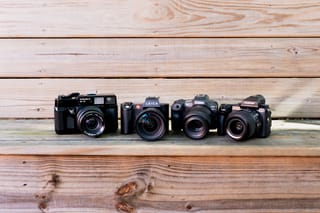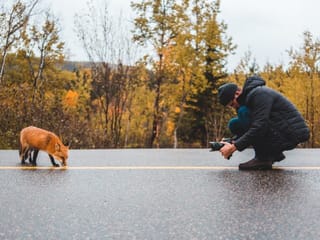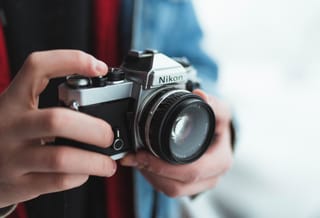
Wildlife photography may seem like an intimidating genre to get into, but you don’t have to book a safari trip to capture high-quality wildlife shots—you can start in your backyard or at the nearest park.
Choosing the Right Wildlife Lenses
To take great images of animals in the wild, all you need is good timing, patience, and the right equipment. A long lens is crucial when it comes to capturing wildlife with crystal-clear image quality, which is why telephoto lenses are ideal for this type of photography. Let’s go through some factors to consider before buying.

SHOP ALL TELEPHOTO LENSES
Focal Length
Telephoto lenses generally start around 100mm for full-frame sensors (75mm for APS-C, 50mm for M4/3), but if you want to get seriously close, a range of 200mm to 800mm is recommended. This will allow you to keep a safe distance from your subject without disturbing them, and still get close-up shots.
Of course, there are disadvantages with going too long, as your depth of field (what’s in focus) gets increasingly narrow. Plus, extremely long lenses tend to be quite large and heavy—not to mention prohibitively expensive. A good compromise is settling for a moderate focal length (around 300mm) and if you need more reach, you can always add a teleconverter, which is much more convenient to carry than an extra lens, though you will lose a stop or two of light depending on the strength of the tele-extender and probably some sharpness too depending on the quality of your lens and the quality and magnification of the converter. Also, keep in mind many lenses and tele-converters are not physically compatible. When in doubt give one of our experts a call and we can advise you on the trade-offs of using a tele-extender.
Aperture
Having a large maximum aperture (generally, an f/ number of 4 or lower) is always a plus for any lens, and telephoto lenses are no different. The wider the aperture, the more subject isolation you can achieve—which means you can blur out distracting backgrounds and make your subject stand out more. Luckily, at long focal lengths you don’t need super-fast lenses to achieve good separation.
Generally, if you’re shooting in daylight, a lens with a maximum aperture of f/4 or f/5.6 is more than good enough to get the job done. In low light conditions, getting down to f/2.8 or even f/2 is a nice luxury, but not a necessity.
Keep in mind that you’ll lose a little bit of light if adding a teleconverter, so having a large maximum f-stop makes a difference in that respect as well. The one downside to lenses with large maximum apertures is that they tend to be expensive and larger in size due to their complex designs.
Autofocus Speed & Noise
While your choice of camera body is the main factor in determining autofocus speed, some lenses have faster motors than others, and that can affect AF speed. If you want to photograph fast-moving subjects, look for lenses that can snap to focus quickly and accurately.
Some lenses are also louder than others when autofocusing. If you don’t want to scare off sensitive subjects with excess noise, especially when shooting birds or jumpy woodland creatures, opt for a lens that focuses quietly.
Image Stabilization
The longer the lens, the harder it is to keep your composition steady. If you don’t want to end up with blurry images, you can use a support like a tripod or monopod, and additionally, get a lens that has built-in stabilization. This feature provides movement and vibration reduction to keep your images nice and sharp, even if you happen to move slightly.
With image stabilization, you’ll be able to get better results at slower shutter speeds while hand-holding your camera. Also, if you plan to shoot from moving objects like boats or piers, stabilization is going to be a key component to getting good results.
Weather-Sealed
If you’re going to be outside, you have to be prepared for adverse conditions. Rain, fog, and humidity are common hazards that can introduce moisture into your equipment. This moisture can lead to fungus and haze within the lens elements over time. Having some weather resistance built into your lens and camera helps to protect your gear.
And it’s not just water you have to worry about—dust, salt, and smoke can all damage your lenses as well. While weather resistance is a good general defense, keep in mind that it doesn’t make your equipment completely impermeable, so you should still use caution and common sense when in the elements.
Weight & Size
Telephoto lenses tend to be bigger than most lenses due to the extreme demands of the optics, but there’s still a notable size difference between models. Obviously, if you plan to hike long distances to reach remote subjects, the size and weight of lenses are important factors.
Canon recently released two specialized, retractable RF lenses which are light and compact for this very purpose—the 600mm f/11 and the 800mm f/11.
Zoom or Prime?
There’s no right answer to this timeless question—it mostly comes down to preference. Prime lenses (those with a fixed focal length) usually offer better optical quality, while zoom lenses (those with a range of focal lengths) offer the convenience of multiple lengths in one package. There are telephoto zoom lenses that can hack it optically with their prime counterparts, but they tend to be quite pricey and large.
If you’re shooting subjects that are constantly moving, such as with bird photography, a lens with a higher zoom range may prove convenient. If you’re shooting subjects that are usually a fixed distance from you, a prime lens would probably work best.
Order Telephoto Lenses for Wildlife Photography Online
Selecting the best camera and telephoto lens can help you photograph wildlife like a true professional. Capture the highest-quality wildlife photos whether strolling through nature or in your own backyard. Get started by browsing our popular telephoto lenses now!








